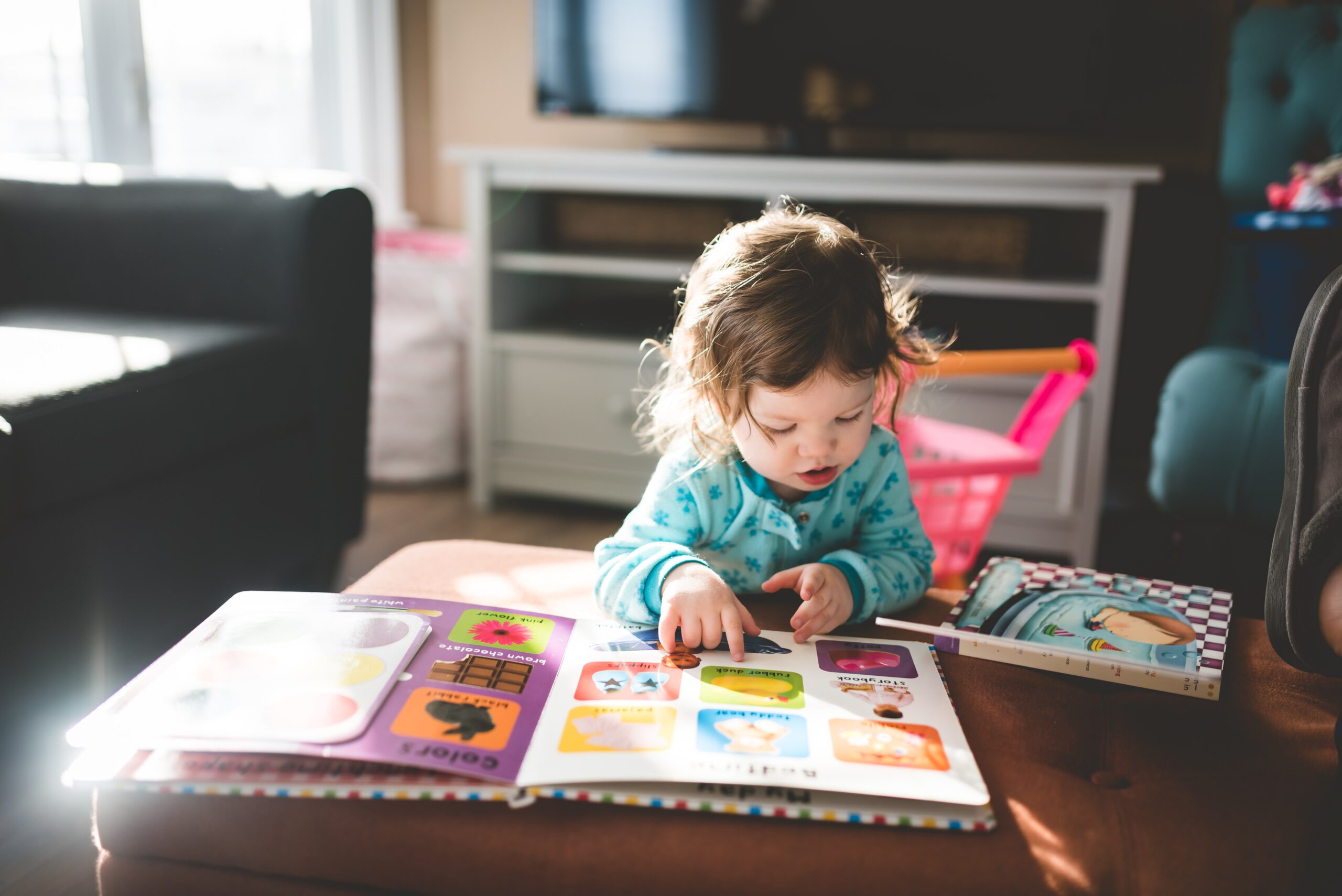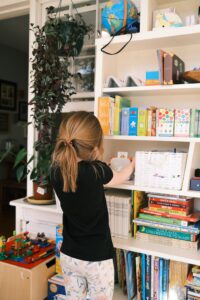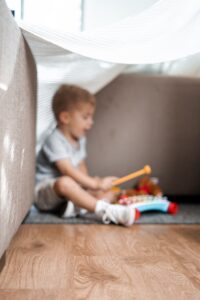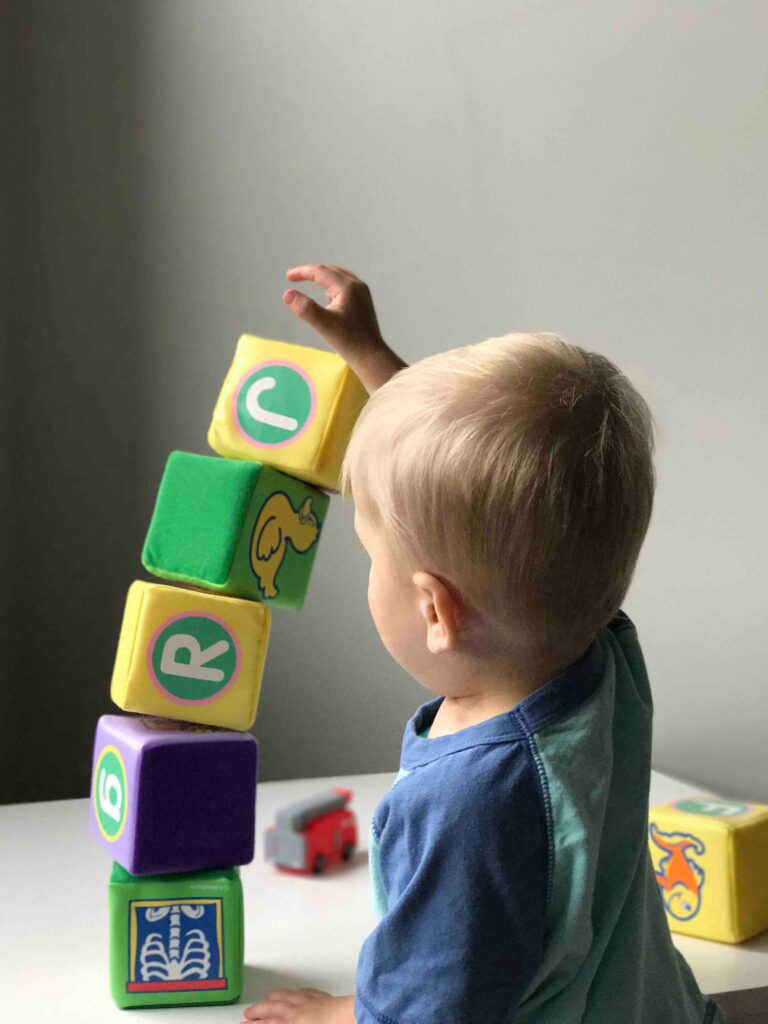“Playrooms are where forgotten toys go to die,” writer Wendy Herman quipped. The idea of a rarely-visited and dusty play space is a disparaging possibility. Whatever dreams we have for our playrooms, we’re likely looking for more than a spot for toys to perish. Instead of a clutter dumping ground, I hope our family’s play space welcomes, engages, and inspires. I want an area for my three kids to learn and my family to connect. With a bit of intentional planning and the use of Maria Montessori’s principles, we can avoid a toy graveyard and create Montessori play spaces that suit our homes and our families.

The First Step In Creating A Montessori At Home Play Space
To create an engaging play space that fits both your home and your family, I recommend starting with a little thoughtful consideration. Instead of cracking open home magazines or, more likely, jumping on Pinterest to see what others have done with their play spaces, it’s helpful to think about what you want out of the space and what will work best for your family. No one on Pinterest knows your family and your home like you do. Taking a minute to form your “expert” opinion on the space can make a dramatic difference in how the space serves your family.
For example, my family uses our home play space most for reading, building, and drawing. Because of this, our space needs a cozy spot to read, a space to build structures, and a drawing surface. The needs of each family will be different. After figuring out the most important items for the space, it’s great to start shopping for the items and brainstorming ways to arrange them. Starting with your family’s goals helps ensure that the space fits exactly what you want it to be.
A Montessori Play Space Throughout Your Home
 Play can happen almost anywhere. The primary play space may not be a separate playroom. A child’s bedroom, a multipurpose bonus room, a basement, or a family room can also host a wonderful Montessori at home play space.
Play can happen almost anywhere. The primary play space may not be a separate playroom. A child’s bedroom, a multipurpose bonus room, a basement, or a family room can also host a wonderful Montessori at home play space.
We have a bedroom designated as the playroom in our home. However, most of the play actually occurs in the living room. I’d love for my kids to keep their “mess” behind the playroom door, but my kids actually want to be near all of the family action when they play. To make this work, we have the most frequently used items at hand in the living room. There are books, as well as drawing and building supplies. Other toys and activities are not far away in the playroom. We use the playroom at times when we can all play together. This setup helps keep the items we use most nearby and easily reached.
Guiding Principles to Create A Montessori at Home Play Space
Maria Montessori created a prepared environment to make her classroom engaging for students. Many of these principles can also apply to Montessori at home play spaces. Of course, parents have the freedom to use the principles that work best for their homes and leave the rest behind. Some guiding Montessori principles include:
- Create open space: Open space in a play area gives kids room to create, build, and move around. This principle can be applied in smaller areas by rearranging furniture to find the optimal configuration.
- Simplify: Include fewer items in a play space. Having fewer toys helps make cleaning easier and also keeps kids from being overwhelmed. Rotating toys is one option for continually refreshing items in a space and having fewer at one time.
- Display items at the child’s level: Making items visible and accessible to children can inspire play. Open shelving low to the ground is one way to achieve this.
- Choose high-quality toys: Toys that are open-ended can be used in many ways and can inspire deeper, more meaningful play. This article is a great overview of Montessori at home toys.
- Prioritize natural materials: Maria Montessori encouraged the use of natural materials in play spaces. Toys made of wood, ceramics, or even sea sponges activate the senses and are beautiful.
- Include child-size furniture: Furniture pieces that are made for kids can help them feel comfortable in their space, promoting independence and autonomy. Furniture that is child-size can also help them feel welcome in the space, as if it were “made for them.”
- Provide opportunities for gross-motor movement: Kids often love to move, and providing opportunities for large muscle movements can help meet this desire. Climbing structures and triangles are one way to provide gross-motor movement opportunities.
A Montessori Play Space In Any Size Area
These principles for creating a Montessori at home play space apply to play spaces of all sizes. Families can create more open space in smaller areas by utilizing vertical storage and having fewer items. Smaller areas may not have room for child-sized furniture, but parents can mediate autonomy and independence through stools and low-hanging hooks to help kids access things they need. Toy and activity storage that is low and open for easy access can also work in smaller spaces. While smaller spaces may not have room for climbing apparatuses, kids can exercise their gross motor skills without any equipment by jumping and crawling.
kids access things they need. Toy and activity storage that is low and open for easy access can also work in smaller spaces. While smaller spaces may not have room for climbing apparatuses, kids can exercise their gross motor skills without any equipment by jumping and crawling.
Because of their versatility, Montessori By Mom Toolboxes are great additions to smaller play spaces. While the materials only take up as much room as a small shipping box, children can use them for hundreds of activities.
While larger spaces inherently have more open space, they can also make it easier to accumulate lots of toys and activities. Maintaining simplicity can require a periodic evaluation of what items are coming into the space and paring them down so that only priority items stay. There may also be a tendency to incorporate substantial furniture pieces to fill up a larger room, but furniture that fits the size of a child can make a wonderful addition.
My family has lived in homes of many sizes, and we have found ways to create effective play spaces in both larger and smaller homes. Smaller spaces have made it easier for us to own fewer items because there is no room for extra items. I also find that people tend to chip in and clean up after themselves more readily in smaller spaces. The space has to stay tidy in order to live and work there. Larger spaces made it much easier for my family to accumulate unnecessary items, but the open space is enjoyable.
Making Your Priorities A Reality

I encourage parents to think intentionally and creatively about the play spaces in their homes. In my experience, most spaces have some sort of challenge or limitation. It has been helpful for me to keep referencing my family’s priorities and not be afraid to make those priorities a reality. Maria Montessori’s guiding principles for Montessori at home play spaces may help in the design of a wonderful space for your family!
Kelly Marie is a former scientist and mother of three young kids. She enjoys writing about her experiences in parenting and regularly creates free printable resources for parents and teachers for her blog Hey Kelly Marie. She currently lives in Kentucky with her family.




0 Comments